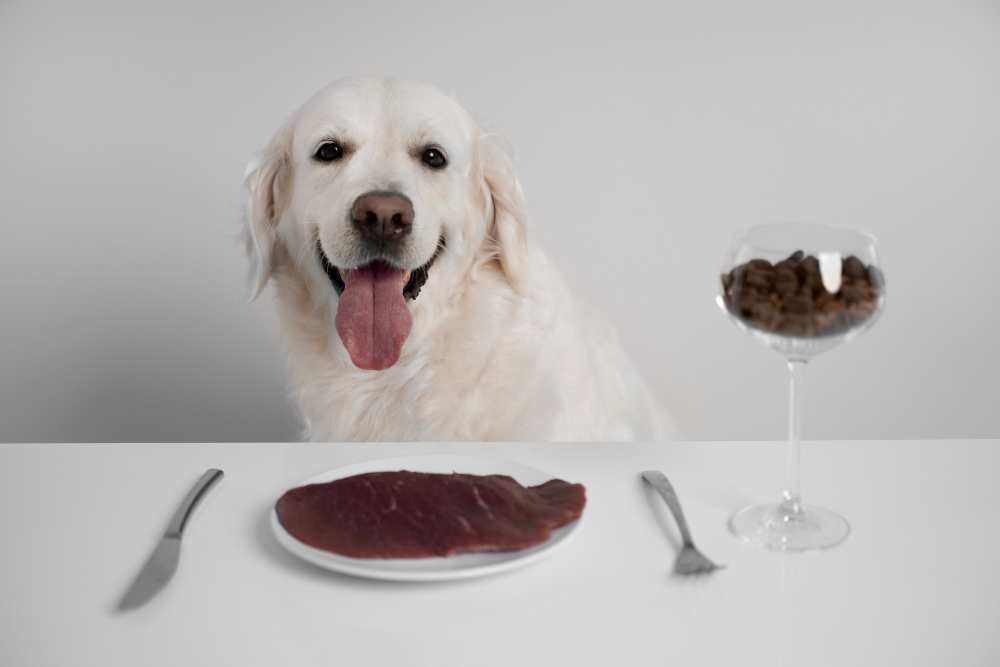3 Toxic Foods for Dogs: Keep Your Pet Safe from Danger
Contents
- 1 Why Are Some Human Foods Toxic to Dogs?
- 2 Toxic Food #1: Chocolate
- 3 Toxic Food #2: Grapes and Raisins
- 4 Toxic Food #3: Onions and Garlic
- 5 Other Common Toxic Foods to Watch Out For
- 6 Tips to Keep Your Dog Safe from Toxic Foods
- 7 What to Do If You Suspect Your Dog Has Eaten a Toxic Food
- 8 Conclusion: Protect Your Dog by Knowing the Risks
Dogs are beloved members of many families, offering companionship, joy, and unconditional love. As pet owners, we naturally want to provide the best care possible, ensuring their health and happiness.
One critical aspect of responsible pet care is understanding what foods are safe for dogs and which are potentially toxic.

Unfortunately, many common human foods can be harmful or even deadly to dogs. These toxic foods may cause anything from mild stomach upset to severe organ damage, neurological issues, or death.
Chocolate, grapes, and onions are three common toxic foods for dogs. Ingesting them can lead to serious health issues, so always keep foods away from pets.
This blog post will explore three toxic foods for dogs that every dog owner should avoid feeding their furry friend, why these foods are dangerous, the symptoms of poisoning, and how to act quickly in case of accidental ingestion.
Why Are Some Human Foods Toxic to Dogs?
Dogs’ digestive systems and metabolisms are very different from humans’. What may be perfectly safe and nutritious for us can sometimes wreak havoc on a dog’s body.
Toxic foods contain substances that dogs cannot adequately digest or eliminate, causing the accumulation of harmful compounds or triggering allergic reactions.
Additionally, dogs vary in size, breed, and health status, meaning the severity of toxicity can differ widely. What might cause mild discomfort in one dog could be fatal in another.
Understanding which common foods are toxic and the potential dangers can help dog owners prevent accidental poisoning and seek timely treatment when necessary.
Toxic Food #1: Chocolate
Why Is Chocolate Toxic to Dogs?
Chocolate is perhaps the most infamous toxic food for dogs. It contains substances called theobromine and caffeine, both of which are stimulants that affect the nervous system and heart.
While humans can metabolize these compounds fairly quickly, dogs process them much more slowly, allowing them to build up to toxic levels.
The amount of theobromine varies depending on the type of chocolate:
- Baking chocolate and dark chocolate have the highest levels of theobromine.
- Milk chocolate has less but is still dangerous.
- White chocolate contains negligible amounts but should still be avoided.
Symptoms of Chocolate Toxicity
The severity of symptoms depends on the amount and type of chocolate ingested, as well as the dog’s size. Common symptoms include:
- Vomiting
- Diarrhea
- Increased thirst
- Restlessness and hyperactivity
- Rapid breathing or panting
- Elevated heart rate or arrhythmias
- Tremors or seizures
- Muscle rigidity
- In severe cases, coma or death
What to Do If Your Dog Eats Chocolate
If you suspect your dog has ingested chocolate, especially in large amounts or dark chocolate, seek veterinary care immediately.
Early treatment can include inducing vomiting, administering activated charcoal to reduce absorption, intravenous fluids, and medications to manage symptoms.

Toxic Food #2: Grapes and Raisins
Why Are Grapes and Raisins Toxic to Dogs?
Grapes and raisins are another common food item that can cause serious harm to dogs. The exact toxic substance within grapes and raisins is unknown, but ingestion has been linked to acute kidney failure in dogs, which can be fatal if untreated.
Even small amounts can trigger toxicity in some dogs, making grapes and raisins particularly dangerous.
Symptoms of Grape and Raisin Toxicity
Signs of toxicity typically appear within a few hours to a day and include:
- Vomiting and/or diarrhea (often within 6 hours)
- Lethargy
- Loss of appetite
- Abdominal pain
- Dehydration
- Increased thirst and urination initially, followed by decreased urination as kidney function deteriorates
- Weakness or collapse in severe cases
What to Do If Your Dog Eats Grapes or Raisins
If your dog consumes grapes or raisins, it is crucial to get emergency veterinary care immediately. Treatment may involve inducing vomiting, administering activated charcoal, intravenous fluids to support the kidneys, and ongoing monitoring of kidney function.
Toxic Food #3: Onions and Garlic
Why Are Onions and Garlic Toxic to Dogs?
Onions, garlic, and other members of the Allium family (including leeks and chives) contain compounds called thiosulfates that are toxic to dogs.
These compounds cause oxidative damage to red blood cells, leading to a condition called hemolytic anemia, where red blood cells are destroyed faster than they can be produced.
While garlic is often considered more toxic than onions, both can be dangerous, especially in larger amounts or with prolonged exposure.
Symptoms of Onion and Garlic Toxicity
Symptoms may not be immediate and can develop over a few days, including:
- Weakness and lethargy
- Pale gums
- Rapid breathing or panting
- Elevated heart rate
- Vomiting and diarrhea
- Reduced appetite
- Dark-colored urine (from blood breakdown products)
- Collapse in severe cases
What to Do If Your Dog Eats Onions or Garlic
If you suspect your dog has eaten onions, garlic, or related foods, prompt veterinary evaluation is necessary.
Treatment may involve decontamination (inducing vomiting or activated charcoal), supportive care, and sometimes blood transfusions if anemia is severe.
Other Common Toxic Foods to Watch Out For
While this blog focuses on three of the most dangerous foods for dogs, many other common foods should also be avoided, including:
- Xylitol: An artificial sweetener found in sugar-free gum, candy, and some peanut butters. Causes rapid insulin release, leading to hypoglycemia and liver failure.
- Alcohol: Even small amounts can cause severe intoxication, respiratory failure, and death.
- Macadamia nuts: Can cause weakness, tremors, and hyperthermia.
- Avocado: Contains persin, which can cause vomiting and diarrhea in some dogs.
- Caffeine: Found in coffee, tea, energy drinks—dangerous like chocolate.
Tips to Keep Your Dog Safe from Toxic Foods
1. Educate Everyone in Your Household
Ensure that every family member, including children and guests, understands which foods are dangerous for dogs. Accidental feeding often happens when well-meaning people share snacks.
2. Store Foods Securely
Keep toxic foods out of reach in cupboards, pantries, and on countertops. Dogs are surprisingly adept at scavenging.
3. Use Dog-Safe Treats
Stick to treats formulated for dogs or safe fruits and vegetables like carrots, apples (without seeds), blueberries, or pumpkin.
4. Avoid Table Scraps
Resist the urge to feed table scraps, especially if you don’t know the ingredients. Many common human foods contain toxic components.
5. Have Emergency Contacts Ready
Keep your veterinarian’s contact info and the number for a pet poison control center handy in case of emergencies.

What to Do If You Suspect Your Dog Has Eaten a Toxic Food
Time is of the essence in managing food poisoning in dogs. If you suspect your dog has eaten something toxic:
- Stay calm but act quickly.
- Remove any remaining food or access to the toxic substance.
- Call your veterinarian immediately or a pet poison control hotline.
- Follow their advice, which may include inducing vomiting if the ingestion was recent and the dog is conscious.
- Monitor your dog closely for symptoms.
- Take your dog to the vet for evaluation and treatment.
Conclusion: Protect Your Dog by Knowing the Risks
Dogs rely on us to keep them safe from dangers they don’t understand, and toxic foods are a common hidden hazard.
Chocolate, grapes/raisins, and onions/garlic are three of the most dangerous foods that can cause serious illness or death in dogs.
By educating yourself, your family and keeping these foods out of reach, you can help ensure your dog stays happy and healthy for years to come.
Remember, if you ever suspect your dog has ingested a toxic food, seek veterinary care immediately. Early intervention can be lifesaving.
.
Reference
Dogs and Chocolate Poisoning: A Toxic Combination
https://www.webmd.com/pets/dogs/features/dogs-and-chocolate-get-the-facts
Foods Your Dog Should Never Eat
https://www.webmd.com/pets/dogs/risky-foods
Dog health
https://en.wikipedia.org/wiki/Dog_health